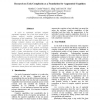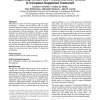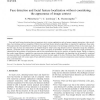1384 search results - page 236 / 277 » Protocol Models of Human-Computer Interaction |
HAPTICS
2003
IEEE
15 years 3 months ago
2003
IEEE
Force-feedback mechanisms have been designed to simplify and enhance the human-vehicle interface. The increase in secondary controls within vehicle cockpits has created a desire f...
HICSS
2003
IEEE
15 years 3 months ago
2003
IEEE
In order to implement real-time adaptive augmented cognition, one of the focal points of our present research involves understanding the dimensions of task complexity. Task comple...
CHI
2009
ACM
15 years 2 months ago
2009
ACM
We build on our prior work with computer-supported teams performing a complex decision-making task on maps, where the distinction between content and process common ground is prop...
IVC
2007
14 years 9 months ago
2007
Face and facial feature detection plays an important role in various applications such as human computer interaction, video surveillance, face tracking, and face recognition. Effi...
150
click to vote
CVPR
2011
IEEE
14 years 1 months ago
2011
IEEE
Existing eye gaze tracking systems typically require an explicit personal calibration process in order to estimate certain person-specific eye parameters. For natural human compu...



